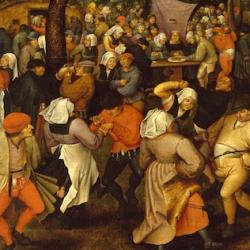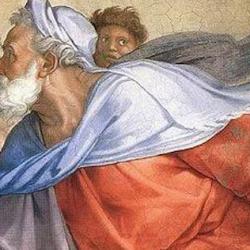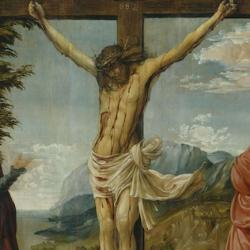John’s gospel differs in many ways from the three “synoptic” gospels. John begins with the majestic prologue that has no analogy in the other gospels. He never once hints that Jesus is an exorcist, he records Jesus’ many visits to Jerusalem, he places the cleansing of the temple early in the book, he records long discourses of Jesus and rarely anything that looks like a parable.
Scholars have given many explanations for the divergences? Brian Peterson’s John’s Use of Ezekiel offers an explanation: John made extensive use of the imagery, structures, and themes of the prophecy of Ezekiel, and that explains many, though by no means all, of the anomalies. Peterson’s list of parallels is impressive: “He sees parallels between the Prologue and the chariot vision of Ezekiel; between the temple cleansing and Ezekiel’s visions of Yahweh’s departure from a defiled temple; between Ezekiel’s denunciation of false shepherds and Jesus’ discourse on the Good Shepherd; between Jesus’ repeated “I am” statements and Ezekiel’s refrain, “you will know that I am Yahweh”; between the Jesus-as-vine discourse of and Ezekiel 15; between the Easter insufflation of John 20 and Ezekiel’s vision of dry bones; between Jesus’ resurrection as the new temple and the new temple visions of Ezekiel 40-48.
Peterson argues for a fundamental structural parallel. Ezekiel, he argues, is organized into two large sections (chapters 1-24, 25-48) each of which includes to great visionary moments (chariot visions [1-3], Yahweh’s departure [8-11]; the dry bones {37]; and the new temple {40-48]). According to Peterson, “John was very much aware of the importance of these visions and has fashioned his Gospel structurally around the theological message connected to the visions of Ezekiel. Thus, Ezekiel’s first two visionary sequences are connected to Jesus’ period of public ministry (John 1–12) whereas Ezekiel’s second two visions are addressed in the last portions of John known as the Farewell Discourses and the post-resurrection scene (John 13–21).”
The placement and focus of Jesus’ “temple action” (John 2) has occasioned much discussion. Why is it at the beginning of Jesus’ ministry rather than, as in the synoptics, toward the end? Again, Peterson finds that comparison with Ezekiel helps unravel the knot: “The basic structural pattern of Ezekiel’s vision in chapters 8–11 is as follows: 1) Ezekiel comes to the temple and sees/hears the abominations in the temple (Ezek. 8); 2) the enactment of judgment takes place (Ezek. 9); 3) Yahweh’s glory/kābôḏ departs from the temple (Ezek. 10); and 4) the visionary/symbolic destruction of the city ensues in Ezek. 11 after the departure of Yahweh’s glory from the city (Ezek. 11:23).” Jesus’ temple action follows the same sequence: He comes to the temple, sees the defilements of those who are trading there, warns of the temple’s destruction, and leaves. As in Ezekiel, Jesus’ departure from the temple is gradual: “In John 2:22, the temple-cleansing pericope ends with the intimated departure of Jesus from the temple. . . . The final appearance of Jesus in the temple comes in John 10, but here it ends with Jesus being driven out of the temple by the unbelief of the people and their attempts to stone him (John 10:31-39 cf. also 8:59). The people’s rejection of Jesus/Yahweh in both accounts effects the departure of God from the temple. . . . What is more, Yahweh moves to a hill outside of the city to effect judgment on Jerusalem, whereas Jesus is crucified outside of the city (John 19:17-20), an act that will have ‘judgment’ repercussions both literally and spiritually.[62] Thus, the temple cleansing scene begins the phased departure of Jesus from the temple, the final aspect of which comes just prior to Jesus’ crucifixion, that is, the destruction of the temple of his body (cf. John 2:19).”
Jesus’ discourses and actions during Passion week and after the resurrection also follow the sequence of Ezekiel. Jesus’ prayer for unity links with Ezekiel’s prophecy that the sticks of Judah and Israel will be tied together, and, as noted, John draws on Ezekiel 37 in his account of Jesus breathing the Spirit on the disciples: “John draws upon that imagery and here instills it with new life as the disciples and the church become the new Israel and are now enabled to have the completeness of what was only begun with Jesus’ earthly ministry. The Passion Week events brought forth the full glorification of Jesus that enabled the giving/ inbreathing of the regenerative work of the cross.”
Peterson acknowledges that the final visions of Ezekiel aren’t described in detail in John, and he correctly argues that the Ezekiel shape of John is completed in the Apocalypse: “Whereas John leaves the disciples awaiting the heavenly return of Jesus (John 14:1-3; 21:23), the author of Revelation picks up on the concept and makes it an eschatological reality. . . . John’s portrayal of Jesus as the fulfillment of Ezek. 40–48 in an eschatological sense does not find complete fulfillment in the Fourth Gospel; the book of Revelation would address these concerns in detail.”
This is an illuminating study. As always, some of the parallels Peterson observes are more convincing than others. At times, he sees parallels between Ezekiel and John that could work equally well for John and any Old Testament prophet. Another point of critique: Peterson says that there is no prediction of the cross in Ezekiel. To be sure, there is no explicit prediction, and no suffering servant; but we can see if when we recognize that Jesus is both true Israel and true temple. As temple He is torn down, bearing the defilements of Israel’s temple; as Israel, He enters the grave for His people, so that the Father can breathe the Spirit to bring His dead bones to life, and make Him life-giving Spirit.














